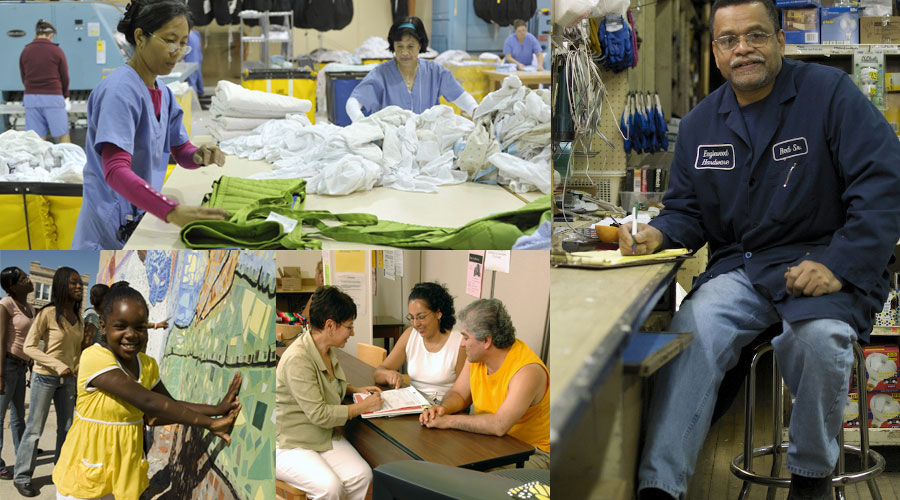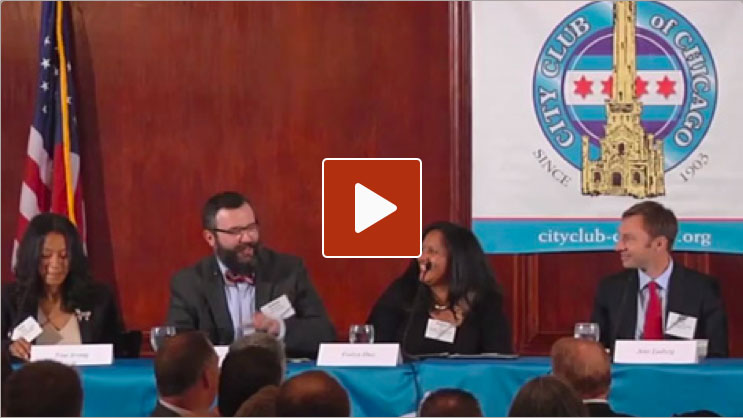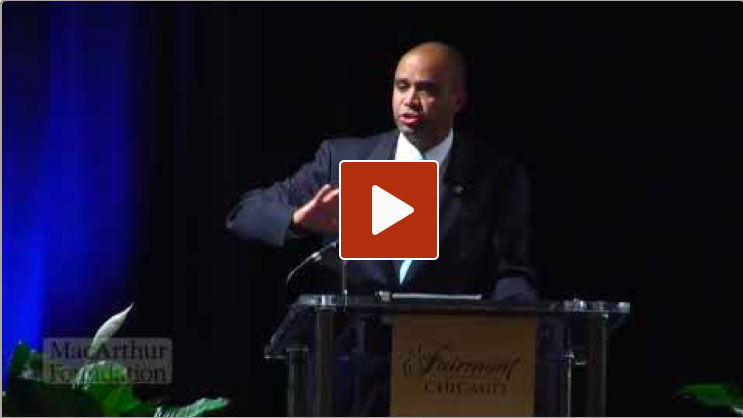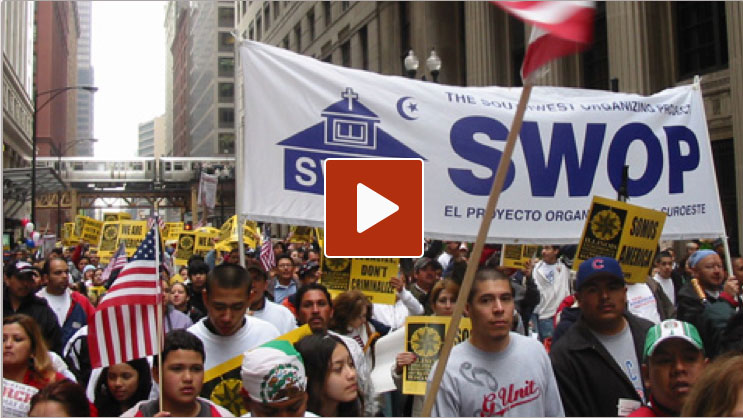
A family enters a home as part of a Chicago Neighborhood Stabilization project.
Summary
From 2001 to 2014, we made 244 grants and program-related investments totaling $215 million.
Our Community and Economic Development Program operated from 2001 to 2014, and worked to increase economic opportunity for low-income individuals and families. The program's central initiative was the New Communities Program (NCP), a coordinated effort led by the Chicago office of the Local Initiatives Support Corporation (LISC) that was piloted in 2001 and formally launched in 2003. NCP supported collaborations of organizations in 16 Chicago neighborhoods to comprehensively address issues that would improve quality of life: employment, health, housing, violence, and more. Over the course of the ten-year period, we invested $58 million directly in LISC which, with additional funds it raised, made $64 million in grants and $24.7 million in loans in the NCP neighborhoods. We provided an additional $200 million in support of complementary activities in the 16 neighborhoods, including $44 million in funding and financing for foreclosure prevention and mitigation, $50 million for the Plan for Transformation of Public Housing, and $11 million in support of an ex-offender reentry demonstration in one NCP neighborhood.
We simultaneously supported a range of national and local organizations to provide technical support to LISC and NCP neighborhoods, including the Center for Economic Progress to increase take up of the Earned Income Tax Credit, and support to LISC for the Financial Opportunity Centers (formerly, Centers for Working Families), that provided financial counseling and employment services to residents of NCP neighborhoods. We supported a network of policy research organizations, such as the Woodstock Institute and the Metro Chicago Information Center, to provide NCP neighborhoods with access to high quality data to guide planning, organizing, program design, and implementation.
through the New Communities Program.
As a further complement to these Chicago-based activities, we supported a small number of national efforts to share information about Chicago with a broader audience, to enable Chicago organizations to learn from other cities, and to strengthen the field of community development nationally. Central among these efforts was support for Living Cities, a group of 18 of the world’s largest foundations and financial institutions that together work to improve the lives of low-income people and the cities where they live. We also supported the national office of LISC to launch the Building Sustainable Communities Program that replicated the NCP comprehensive neighborhood development approach in ten LISC programs around the country. Support was also provided to a network of local data managers led by the Urban Institute that promotes the use of neighborhood information systems in local policymaking and community building.
Beginning in 2006, MDRC, a policy research and evaluation organization, led the evaluation of the New Communities Program. MDRC conducted both quantitative and qualitative research that included methodological briefs; detailed program assessments for each local site; periodic field memoranda to provide ongoing feedback about program implementation and analysis of performance management systems; and interim and final evaluation reports describing implementation and program outcomes. The research advanced our understanding of the challenges of measuring community-level change and led to a series of publications, in progress, that will describe the extent of organizational networks in New Communities Program neighborhoods, and how such networks have changed over the course of the initiative.
In interim and ten-year evaluation reports, MDRC described NCP as well-managed, a rarity among community initiatives that, due to the breadth of interventions and the difficulty of quality control across so many areas of work in each neighborhood, tend to be poorly managed and to flounder in trying to "fix everything" at once. Also noteworthy was the finding that most of the neighborhoods built strong collaborations of local partner organizations, which, relative to histories in many of these areas where intensive competition for available funding and fractious political environments were the norm, became true joint ventures. As a result of good planning that produced strong consensus on priority areas of work, the partner organizations worked together to mobilize the funding and to leverage other sources of support to carry out their redevelopment plans. MDRC documented the success of efforts to diversify the range of areas within which each neighborhood was working. Notably, few led with their former focus on housing in favor of a truly comprehensive range of efforts – violence prevention, education, employment development, housing development, and more – all designed to help build more economically diverse neighborhoods.
A Legacy of Community Support
Our commitment to NCP paid off. Over the course of the initiative, more than $600 million in new investment, from a range of public and private sources, was invested in the 16 neighborhoods. With this funding, local partner organizations were responsible for over 3,000 new and preserved affordable units of housing and 90,000 square feet of commercial space in the neighborhood. In addition, over 50,000 residents accessed financial counseling, income supports and employment services through the Financial Opportunity Centers operated in a majority of NCP neighborhoods. The result was over 5,600 residents were placed in jobs, 1,600 increased their household net income, and over 800 improved their credit score.
The decades of intensive support to local initiatives in Chicago and elsewhere underscored the extent to which market failures, principally housing markets in the wake of the foreclosure crisis but also continued weaknesses in the job market for youths, undermined progress made in NCP neighborhoods. This work also underscored how quickly the failure of public services, policing foremost among them, continually work against even strong local revitalization efforts. These factors encouraged a renewed recognition that progress requires simultaneous attention to opportunities within and beyond individual neighborhoods, including the health of key markets and the quality of public services, the effective functioning of which are vital to efforts to improve quality of life in neighborhoods. These lessons are informing the next stage of our work in Chicago as we search for more and better ways to support local initiatives to improve quality of life for city residents.

Grantee work focused on partnerships designed to leverage new data and analytics to better understand cities.
Information, Cities, and Governance
Recognizing that the rise of new data and analytics produced within and about cities is enabling innovative approaches to understanding the complex and interconnected challenges they face, we initiated a grantmaking exploration in 2012 to examine the potential of the emerging field of research and practice assembling at the intersection of cities, information, and governance. Working under the assumption that without a range of new institutional capacities and partnerships capable of bridging the deep technical divide, keeping pace with the rapid change of information technologies and maintaining a sharp focus on the public good, cities and society may miss opportunities to capitalize on these rich information resources to improve conditions for urban residents.
Grants were focused on institutional partnerships designed to leverage new data and analytics to better understand cities, and to apply these new analytic tools to support cities to make better-informed decisions on pressing urban challenges. Our portfolio included a number of emerging university-based "urban science centers" that are building partnerships with local governments in the U.S. and UK, including the University of Chicago's Urban Center for Computation and Data, the New York University's Center for Urban Science and Progress, and the Bartlett Centre for Advanced Spatial Analysis at the University College of London. Grants also supported policy research organizations such as RAND and the Trust for Public Lands that have long-established experience applying a range of analytics as decision support tools for cities adapting to climate change. Recognizing the growing number of such city-university partnerships, we also provided support to establish the MetroLab Network, a Carnegie Mellon University-based peer learning network of 38 local government-university partnerships.
A portfolio review conducted by Foresight R&D entailing grantee interviews and examinations of grant reports and products illuminated early lessons from this emerging field of research and practice. The reviewers found that MetroLab's growth from 21 member cities at its launch in 2015 to 38 local government-university partnerships by 2017 suggests that these new institutional capacities and city partnerships are catching on. Foresight R&D also found that with this rapid growth has come several critical determinants of whether these university-based centers will become central and permanent players in strengthening local government performance. Effectively leveraging urban data to inform decision-making processes depends on both local government capacities that vary greatly within and among cities, and university success in building cross-disciplinary approaches and teams that can translate often arcane data into practical decision support tools for improving local government.
What We Learned
We learned that among the many challenges of these partnerships are three central ones:
- The question as to whether universities gain sufficient understanding of the complicated political, social, and financial constraints common to most local governments in order to become effective translators of information in ways that have practical applications;
- The fact that data and analytics are very expensive, raising the question of whether there are business models that might sustain these activities over time; and
- The difficulty of training what in some cities is an aging public sector workforce to effectively consume and use the range of new data alongside the challenges many local governments will face in competing with the private sector to attract and retain talent with the necessary analytic skill set.
Notwithstanding these challenges, grantees gained important insights into urban dynamics and the challenges of translating new information sources to improve local government practice.
While this formal exploration has ended, we are building on these lessons to inform the next stage of our work in Chicago.
Additional Resources
Staff
- Herman Brewer
- Maurice Classen
- Alaina Harkness
- Craig Howard, Director
- Meredith Klein
- Susan Lloyd, Director
- Mijo Vodopic, Senior Program Officer
- Spruiell White





